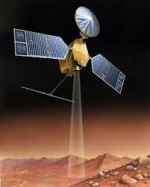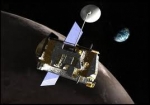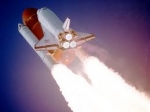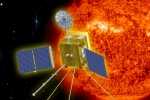Displaying items by tag: orbiter
2001 Mars Odissey (Mars orbiter)
2001 Mars Odyssey is a robotic spacecraft orbiting the planet Mars. The project was developed by NASA, and contracted out to Lockheed Martin.
Its mission is to use spectrometers and electronic imagers to detect evidence of past or present water and volcanic activity on Mars. It is hoped that the data Odyssey obtains will help answer the question of whether life has ever existed on Mars. It also acts as a relay for communications between the Mars Exploration Rovers, Mars Science Laboratory, and the Phoenix lander to Earth. The mission was named as a tribute to Arthur C. Clarke, evoking the name of 2001: A Space Odyssey.
Odyssey was launched April 7, 2001 on a Delta II rocket from Cape Canaveral Air Force Station, and reached Mars orbit on October 24, 2001, at 2:30 a.m. UTC (October 23, 7:30 p.m. PDT, 10:30 p.m. EDT). The spacecraft's main engine fired in order to brake the spacecraft's speed, which allowed it to be captured into orbit around Mars. Odyssey used a technique called "aerobraking" that gradually brought the spacecraft closer to Mars with each orbit. By using the atmosphere of Mars to slow down the spacecraft in its orbit, rather than firing its engine or thrusters, Odyssey was able to save more than 200 kilograms (440 lb) of propellant. Aerobraking ended in January, and Odyssey began its science mapping mission on February 19, 2002. It is currently in a polar orbit around Mars with an altitude of about 3,800 km or 2,400 miles.
By December 15, 2010 it broke the record for longest serving spacecraft at Mars, with 3,340 days of operation, claiming the title from NASA's Mars Global Surveyor.
Mars Reconnaissance Orbiter
Mars Reconnaissance Orbiter (MRO) is a multipurpose spacecraft designed to conduct reconnaissance and Exploration of Mars from orbit.
The spacecraft was built under the supervision of the Jet Propulsion Laboratory (JPL). The mission is managed by the JPL, at California Institute of Technology, La Canada Flintridge, California, for the NASA Science Mission Directorate. It was launched August 12, 2005, and attained Martian orbit on March 10, 2006.
In November 2006, after five months of aerobraking, it entered its final science orbit and began its primary science phase. As MRO entered orbit it joined five other active spacecraft which were either in orbit or on the planet surface: Mars Global Surveyor, Mars Express, Mars Odyssey, and two Mars Exploration Rovers; at the time a record for the most operational spacecraft in the immediate vicinity of Mars.
MRO contains a host of scientific instruments such as cameras, spectrometers, and radar, which are used to analyze the landforms, stratigraphy, minerals, and ice of Mars. It paves the way for future spacecraft by monitoring Mars' daily weather and surface conditions, studying potential landing sites, and hosting a new telecommunications system. MRO's telecommunications system will transfer more data back to Earth than all previous interplanetary missions combined, and MRO will serve as a highly capable relay satellite for future missions.
Lunar Reconnaissance Orbiter (LRO)
The Lunar Reconnaissance Orbiter (LRO) is a NASA robotic spacecraft currently (April 2013) orbiting the Moon on a low 50 km polar mapping orbit.
The LRO mission is a precursor to future manned missions to the Moon by NASA. To this end a detailed mapping program will identify safe landing sites, locate potential resources on the Moon, characterize the radiation environment, and demonstrate new technology. The probe will make a 3-D map of the Moon's surface and has provided some of the first images of Apollo equipment left on the Moon. The first images from LRO were published on 2 July 2009, showing a region in the lunar highlands south of Mare Nubium (Sea of Clouds).
Launched on June 2009, in conjunction with the Lunar Crater Observation and Sensing Satellite (LCROSS), as the vanguard of NASA's Lunar Precursor Robotic Program, this is the first United States mission to the Moon in over ten years. LRO and LCROSS are the first missions launched as part of the United States's Vision for Space Exploration program.
Space Shuttle
The Space Shuttle was a partially reusable launch system and orbital spacecraft operated by the NASA for human spaceflight missions.
The system combined rocket launch, orbital spacecraft, and re-entry spaceplane with modular add-ons. The first of four orbital test flights occurred in 1981 leading to operational flights beginning in 1982. It was used on a total of 135 missions from 1981 to 2011 all launched from the Kennedy Space Center, Florida.
The Space Shuttle at launch consisted of the Orbiter Vehicle (OV), one external tank (ET), and two Solid Rocket Boosters (SRBs). The orbiter decelerated in the atmosphere before flying like a glider but with reaction control system thrusters before landing on a long runway.
The final Space Shuttle mission was in July 2011 to deliver parts to the International Space Station (ISS).
Solar Orbiter (SolO)
Solar Orbiter (SolO) is a planned Sun-observing satellite, under development by the European Space Agency (ESA). The main mission scenario is a launch by an Atlas V from the Kennedy Space Center in Florida in January 2017.
SolO is intended to perform detailed measurements of the inner heliosphere and nascent solar wind, and perform close observations of the polar regions of the Sun, which is difficult to do from Earth, both serving to answer the question 'How does the Sun create and control the heliosphere?'
Space Shuttle program
The NASA's Space Shuttle program, officially called Space Transportation System (STS), was the United States government's manned launch vehicle program from 1981 to 2011. The winged Space Shuttle orbiter was launched vertically, usually carrying four to sevenastronauts (although eight have been carried) and up to 50,000 lb (22,700 kg) of payload intolow Earth orbit (LEO). When its mission was complete, the shuttle could independently move itself out of orbit using its Maneuvering System (it oriented itself appropriately and fired its main OMS engines, thus slowing it down) and re-enter the Earth's atmosphere. During descent and landing the orbiter acted as a re-entry vehicle and a glider, using its OMS system and flight surfaces to make adjustments.
The shuttle is the only winged manned spacecraft to have achieved orbit and land, and the only reusable space vehicle that has ever made multiple flights into orbit. Its missionsinvolved carrying large payloads to various orbits (including segments to be added to theInternational Space Station), provided crew rotation for the International Space Station, and performing service missions. The orbiter also recovered satellites and other payloads (e.g. from the ISS) from orbit and returned them to Earth, though its use in this capacity was rare. Each vehicle was designed with a projected lifespan of 100 launches, or 10 years' operational life.
The program started in the late 1960s and dominated NASA's manned operations since the mid-1970s. According to the Vision for Space Exploration, use of the space shuttle was to be focused on completing assembly of the ISS by 2011, after which it was retired. NASA planned to replace the shuttle with the Orion spacecraft, but budget cuts have placed full development of the Orion craft in doubt. The program commenced on April 12, 1981, withColumbia and STS-1, the first shuttle orbital flight. The space shuttle program finished with its last mission, STS-135 flown by Atlantis, in July 2011, retiring the final shuttle in the fleet. The Space Shuttle program formally ended on August 31, 2011.







